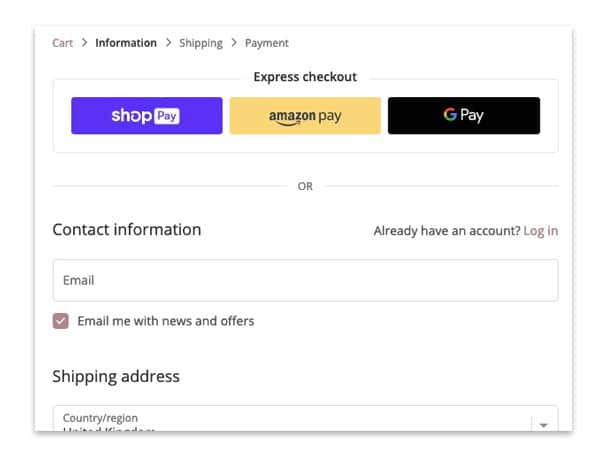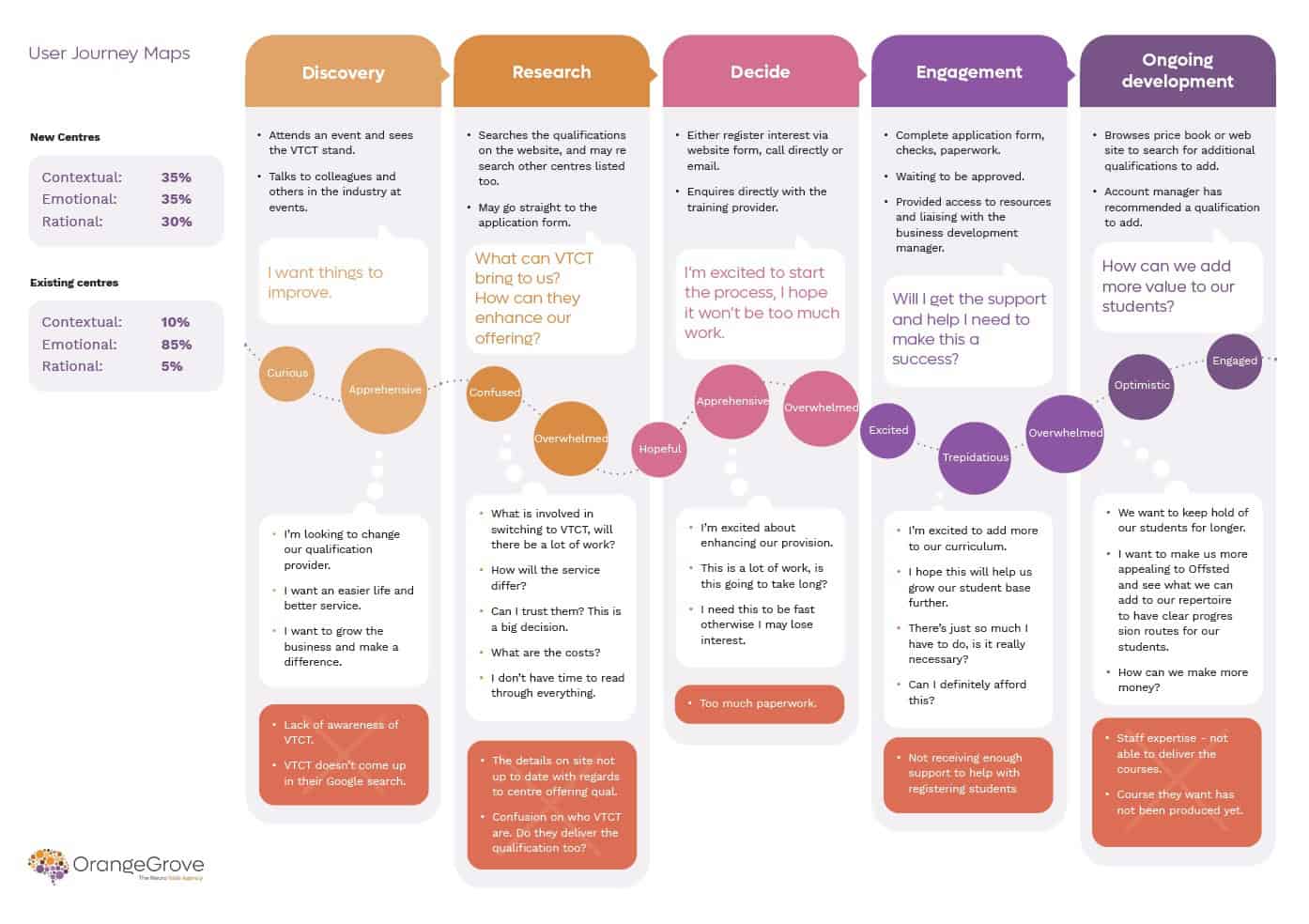Customer journey mapping: an essential guide

How well do you understand the process your customer goes through when interacting with your business?
In today’s fast-paced and highly competitive business world, creating a customer-focused journey is essential. Therefore understanding how your customers interact with your brand along the entire journey, helps to build long-term customer relationships and can improve your bottom line.
This is where customer journey mapping comes into play.
What is customer journey mapping?
Customer journey mapping, also known as user journey mapping, visually brings to life the customer’s experiences and interactions with your product or service. It highlights the different stages of the customer’s journey, from the initial point of contact to the final purchase, and beyond.
A digital customer journey map focuses on the digital user journey. It usually includes the step preceding the interaction, as well as the step following it. Doing this provides a more well-rounded and wholesome picture of the customer’s experience with the brand.
“A customer journey map template” can be used to highlight the different steps a customer takes when interacting with a brand. These steps include what the customer is thinking and feeling at each stage.
These maps are often created using data gathered through customer feedback, surveys, and analytics. They will also be specific to individual customer personas.
What are the components of a customer journey map?
Each customer journey map will focus on one persona group. Therefore, it’s likely you’ll need multiple maps for one business.
The key components of a customer journey map typically include, the stages of the customer journey, customer interactions, customer emotional state, as well as thoughts and barriers. Let’s take a closer look at each of these elements.
Customer personas
Customer personas are an important component of a customer journey map. These are fictional representations of your ideal customers, based on data and research about their behavioural characteristics. By creating customer personas, you can better understand your customers’ needs, wants, and pain points. Then you’re able to tailor your marketing and customer service efforts accordingly.
Having behavioural insight into the personas, enhances customer journey maps further by allowing businesses to empathise, and therefore resonate, with their audience more effectively.
Customer journey
The stages of the customer journey are typically broken down into several steps or phases, which might include discovery, research, decision, and engagement. These stages represent the customer’s journey from the initial point of contact with your brand to the final purchase and beyond. By breaking down the customer journey into these stages, you can better understand how customers interact with your brand and identify areas where you can improve their experience.
Customer interactions
Customer interactions will show which activities the customer has performed at each specific phase of their journey. These can include performing a search engine search, seeing an advert on social media channels, filling out a contact form, making a purchase, or contacting customer support. By identifying each action and touchpoint at each phase of their journey, it is then possible to identify where the customer experience can be improved.
Customer emotional state
Considering the customer’s emotions is essential for customer journey mapping. It helps identify pain points and areas for improvement in the customer experience. For instance, if customers feel frustrated when completing a purchase online, it’s possible to solve this by looking for a simpler checkout process. Additionally, it brings personas to life and enables a more human-centred, problem-solving approach.
A study, published in the Journal of Business Research supported this. It found that customer journey mapping can be a valuable tool for understanding the emotional experiences of customers and identifying areas where these experiences can be improved (Homburg et al., 2017).
Customer thoughts
Knowing the thoughts and questions that go through the customer’s head whilst interacting with your brand, also helps with a human-centred approach. Copy can be tailored to incorporate the insights for better resonance and engagement.
Customer barriers
Aside from the thoughts and fears customer face when interacting with your brand, they can also come up against more physical barriers which may limit or halt their onward journey altogether. These could be anything from limited payment options or insufficient customer support. Including these in the customer journey map will allow these issues to be addressed quickly.

Why is customer journey mapping essential?
The benefits of customer journey mapping are numerous, and it can be valuable for every member of your team, from designers to marketers to CEOs and more. Let’s take a closer look at why each team member can benefit from customer journey mapping.
Designers
Customer journey mapping helps designers create products and services that meet customers’ needs and enhance their overall experience. By understanding the customer journey, designers can create products and services that meet the needs of customers and improve their overall experience.
CMOs and marketers
Customer journey mapping is a valuable tool for marketing teams as it helps them to better understand the needs and desires of their customers at every stage of their journey. A study published in the Journal of Marketing Management, found that by understanding the customer journey, marketing teams can create more effective marketing strategies and communication plans that are tailored to the specific needs of their customers. (Gentile et al., 2017).
Customer support teams
For customer support teams, customer journey mapping can help identify pain points and areas where support can be improved. By understanding the journey, support teams can provide personalised support that meets the needs of individual customers and helps build long-term relationships.
CEOs
For CEOs, customer journey mapping provides valuable insights into how customers perceive the brand and where improvements can be made. CEOs can then make informed decisions about investments in product development, marketing, and customer support to improve the overall customer experience and drive growth.
According to a study published in the Journal of Service Management Research, they can also help improve customer retention, increase customer satisfaction, and drive customer loyalty. Resulting in a more personalised and engaging experience whilst building long-term relationships and increasing customer lifetime value. (Frow et al., 2016).
As you can see, customer journey maps are essential tools for marketing, sales and customer support teams looking to build a more customer-centric approach and improve the overall customer experience.
So, how do I get started with a customer journey map?
Step 1: To get started creating a customer journey map, first begin by identifying your customer personas and the stages of the customer journey. What identifiable groups do your target audience fall into?
Step 2: Then use data and research to identify the actions, thoughts, feelings and barriers the customer experiences at each stage of the journey. Do this by gathering feedback from customers as well as customer service and sales representatives.
Interviews with the representatives are the best way to gather this information. As well as through any previous customer surveys and such like.
Step 3: Refine. You will have gathered a lot of information and now it needs to be condensed to the most important and most useful, and then organised.
Step 4: Finally, it’s time to bring it all to life. Design is used to visually enhance the customer journey phases and the outcome of the research. Be sure to involve key team members in the process, including designers, marketers, and customer support teams, to ensure that the map accurately reflects the customer experience and provides valuable insights for improving it. Ultimately it’s important the tool will be referred to by all team members, so it needs to work well for them all.
Here’s an example of a customer journey map:
In Summary
Customer journey mapping is a useful tool for any business looking to build a customer-focused approach and improve their overall customer experience.
By understanding the different stages of the customer journey, the needs and desires of your customers, and the touchpoints and interactions that occur along the way, you can create a personalised and engaging experience.
What every business wants is loyal customers and to drive growth. Customer journey mapping helps with exactly this.
References:
Frow, P., Nenonen, S., Payne, A., & Storbacka, K. (2016). Managing co‐creation design: A strategic approach to innovation. Journal of Service Management Research, 1(2), 20-33.
Homburg, C., Jozić, D., & Kuehnl, C. (2017). Customer experience management: Toward implementing an evolving marketing concept. Journal of Business Research, 81, 141-149.
Gentile, C., Spiller, N., & Noci, G. (2017). How to sustain the customer experience: An overview of experience components that co-create value with the customer. Journal of Marketing Management, 33(1-2), 67-89.
All our resources are FREE
Want to stay updated?
Get instant updates on our latest news and resources by subscribing to our mailing list
"*" indicates required fields
Related Services
Customer journey mapping
Look to uncover key opportunities in a customer's digital journey using a neuro-focused approach, which highlights their problems, tasks, questions and emotions.
Customer journey mapsGet your SmartSite score!





